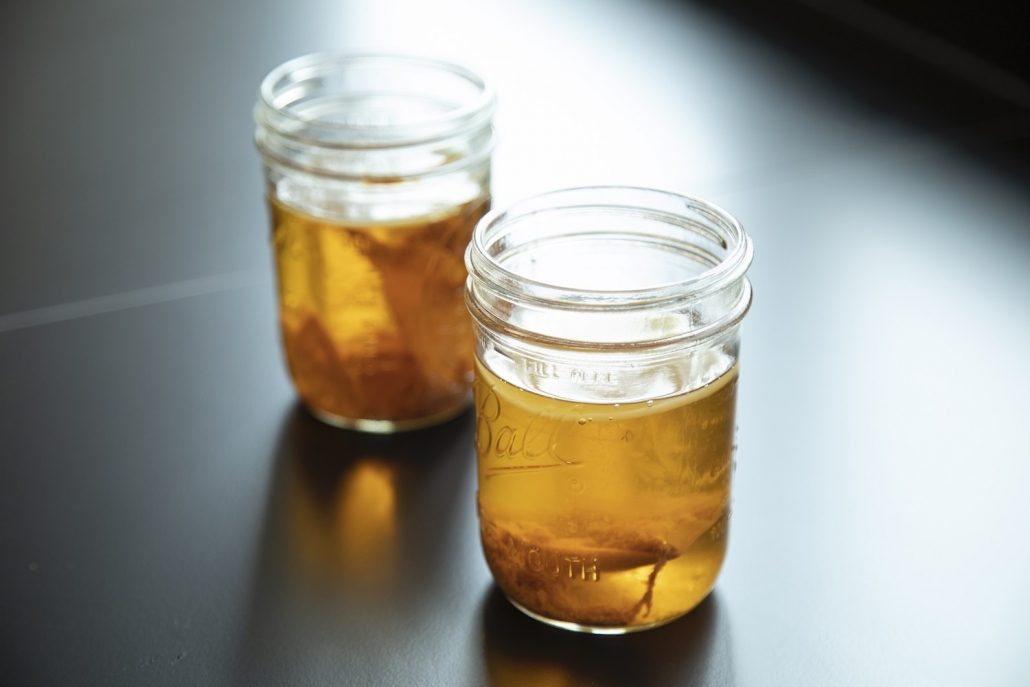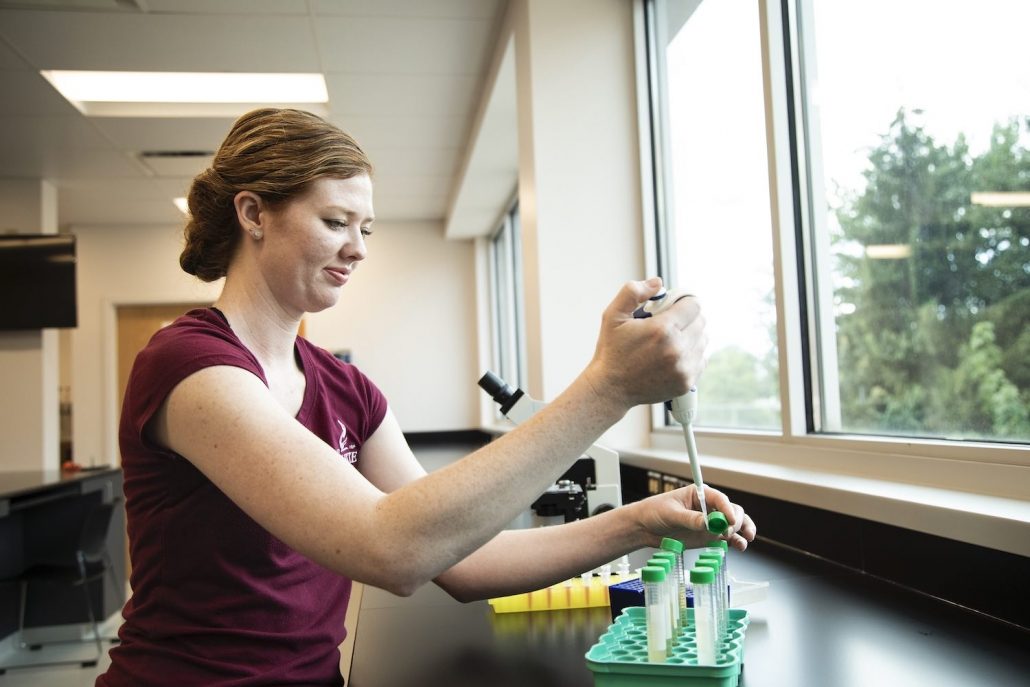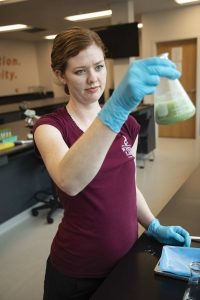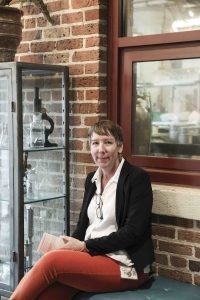Mountain Brew
WHAT REALLY TURNS (SUGAR) WATER INTO WINE: MAGICAL YEAST
By Anne Fitten Glenn | Photos by Erin Adams
Earlier in my career, I worked at Oskar Blues Brewery in Brevard and regularly gave tours to visitors. A question I heard more than once was, “When is the alcohol added?” If you understand fermentation, this may seem like a strange question. But if you’ve never made beer, wine, or fermented foods at home, it’s not an unreasonable one. The process of fermentation can be confusing, as it requires a living microorganism, yeast, to transform grapes into wine, barley into beer, and corn into bourbon.
“For so, so long, humans really didn’t understand how fermentation worked—even though they had been fermenting beverages for thousands of years,” says Jo Doyle, education and engagement curator at the Asheville site of White Labs, a liquid yeast culture company.
Fermentation is the process by which yeast converts sugar to carbon dioxide and alcohol. A high school biology teacher looking to explain it might say that yeast eats sugar and poops out CO2 and alcohol. Doyle notes that yeast (the word is plural as well as singular) don’t have mouths or anuses, which is a good point. Alcohol is merely a happy byproduct of yeast’s amazing conversion ability. Anything that contains sugar can ferment, either naturally or by adding yeast in a kitchen or manufacturing business.
“You wouldn’t have any alcoholic beverages without yeast. It’s the least understood player in the ingredients for beverages,” Doyle says. “There’s no alcohol without yeast. Period.”
When European settlers first set down roots in Western North Carolina, they used whatever native fruits, grains, or vegetables they could forage or grow to make alcoholic beverages. They fermented black locust pods, persimmons, seeds, berries, and honey. And, of course, they fermented corn, which originally was cultivated throughout the region by Native Americans, becoming the grain base for one of WNC’s most revered and reviled beverages: moonshine.
Folks understood that mashing a bunch of fruit in a bucket or barrel and leaving it to bubble would ultimately result in something intoxicating. This process, spontaneous fermentation, occurs when microorganisms in the air are allowed to inoculate the liquid. It’s also known as wild fermentation, and the yeast that naturally come into contact with and start metabolizing the sugars are referred to as wild yeast.
“Yeast is in the air around us all the time. It’s alive, and it’s literally everywhere,” says Mary Daniel, White Labs’ Asheville lab supervisor.
Doyle adds that “in the Middle Ages, they called the froth that happened during fermentation ‘godisgood’—all one word. They didn’t know what produced the alcohol, so they assumed it must have been divine intervention.”
All spirited liquids were spontaneously fermented until Louis Pasteur first identified and isolated yeast in the late 1860s. That made businesses like White Labs possible. The company grows, propagates, and banks hundreds of yeast strains for businesses around the world.
The craft beverage revival of the past 20 years would not have been possible without the manufacture of yeast, and many breweries, wineries, distilleries, cideries, kombucha makers, and meaderies depend on companies like White Labs to provide them with high-quality, consistent yeast. “It was very expensive to get yeast cultures in the 70s. All the styles of beer follow the availability of specific strains of yeast,” says Daniel. “People don’t realize that yeast contributes more than 600 flavor and aroma compounds to your beer.”
 Clove, banana, pear, and green apple are a few of the more common flavors associated with yeast in beer. Wine yeasts can produce flavors of strawberry, peach, grass, and even cheese.
Clove, banana, pear, and green apple are a few of the more common flavors associated with yeast in beer. Wine yeasts can produce flavors of strawberry, peach, grass, and even cheese.
For example, “you can’t have a Saison without that specific style of yeast strain,” Doyle says. “While you do have workhorse strains that can produce a variety of styles, some styles are impossible without a specific strain.”
“People ask us all the time, ‘Where do you get your yeast?’ I tell them that they are all unique and they all come from different sources,” Doyle says. In one case, Oregon-based brewery Rogue Ales created a beer with yeast cultivated from a brewer’ beard. “Every strain has a story. Yeast is like you or me. Each strain has its own DNA and its own behaviors.”
Daniel offers a helpful metaphor, saying, “Yeast are like dogs and cats. Ale yeast are dogs while lager yeast are cats. But just as there are different breeds of dogs and cats, there are all different strains of yeast. You have your big dogs and your tiny dogs and your lazy dogs and your highly energetic dogs.”
“And those are the domesticated strains,” Doyle adds. “What about the wild strains? As Dr. Karen Fortmann [a senior scientist at White Labs] has said, ‘These are the coyotes of the yeast world. They will eat out of the dumpster and overrun all the other canines!’”
As history is cyclical, so too is beverage production. Whatever yeast was in the air, that was what you got in your drink for a long, long time. But once people started to understand how to grow yeast themselves, these cultured strains became favored by the industry. Yet today, some beverage manufacturers are returning to the wild.
The number of wild ale and farmhouse-focused breweries today is significant compared to 10 or more years ago when you saw almost none,” says Bill Zimmer, co-owner of Ecusta Brewing Company in Brevard. “However, wild yeast has always been a staple in Belgium and throughout brewing history.”
While most breweries typically use cultivated yeast, many will brew a few wild fermented ales annually. Zimmer’s brewery has tapped into the explosion of interest around Kveik, a Norwegian farmhouse-style yeast that recently has become popular with American brewers, with the release last spring of its Trail Ale, which uses the yeast strain. For small-batch production, wild yeast is viable, although customers should understand that the taste of the resultant liquid likely will not be consistent from batch to batch. The strains of yeast floating invisibly through the air are apt to change over time and are influenced by a huge variety of factors, from temperature to air quality to seasonal pollens.
“I think the single largest advantage to wild yeast is the complexity of flavor you can create,” Zimmer says. “Having your own unique house culture allows a large amount of creativity to come through, and the cost of utilizing wild yeast can be cheaper than packaged yeast. But disadvantages can include off-flavors, spoilage, and inconsistency.”
Beverage manufacturers must be cautious as wild yeast in the air can infect or change the taste of their products during production. Cleanliness is mandatory. In-house yeast cultivation and handling require meticulous care.

Vigorous lab testing and environmental monitoring is a priority at White Labs, notes Daniel. She tells stories about obsessively placing Petri dishes around the facility to check for contamination.
And then there’s the research and development necessary to produce new yeast strains based on industry trends. Alcoholic seltzers have become hugely popular, and White Labs’ customer service reps field multiple calls daily about which yeast to use to make these drinks, per Doyle.
“We have to keep our fingers on the pulse of what people want to drink and what breweries and other businesses want to make,” Doyle says. “Yeast production follows that.” ◊◊
Anne Fitten Glenn is the author of two beer history books: Western North Carolina Beer and Asheville Beer. She has been writing about the fascinating world of alcoholic beverages for more than 15 years. Her radio show and podcast, Imbibe Asheville, covers the business of beverages from yeast to glass.
Save
Save
Save
Save
Save
Save
Save
Save
Save
Save

Mary Daniel, lab supervisor at White Labs in Asheville

Jo Doyle, education and engagement curator at White Labs
THE WEEKLY REVEL
Sign up for your free handpicked guide to enjoying life around Asheville.
Available weekly from May to October.





